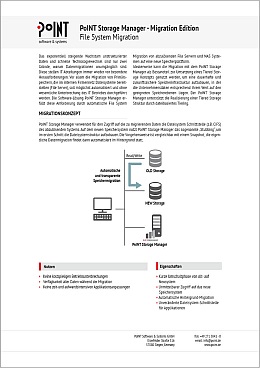Challenges of successful data migration
A data migration aims to transfer data quickly and reliably from one system to a new one. Every migration must be planned cautiously and with foresight:
- Applications and business processes should be affected as little as possible.
- Unavoidable interruptions ("downtime") should be plannable and short.
This is where the greatest challenges for a data migration arise. At the same time, a migration project holds a lot of potential for improvement:
- Switching to a new technology
- Improvement of data quality as early as during the preparation for migration
- Opportunity for comprehensive infrastructure optimization
Storage Migration
As part of a storage migration, old storage systems and/or storage media are replaced by new ones. The data must be moved from the old to the new systems.
This particular example shows why data migrations are unavoidable:
- Limited lifetime of storage media:
It is assumed that storage systems are due for replacement every 5 to 7 years in order to maintain the readability of the data. - Obsolescence of storage systems:
Storage systems need to be replaced due to technology changes and new requirements. - Growing data volumes:
One of the biggest challenges in storage is the unchecked growth of data. The large volumes of data must be stored securely, and companies must adapt their storage strategy accordingly.
Optimization potential for the storage infrastructure
A data migration provides an opportunity to optimize the entire storage infrastructure. When preparing for migration, check which data is active and which is inactive.
Often, inactive, cold data occupies valuable resources on expensive primary storage. This data is only accessed in exceptional cases. Nevertheless, it must be retained due to legal or corporate regulations. This data can be moved to less expensive secondary storage and archived there. This frees up capacity on primary storage.
The principle of Information Lifecycle Management takes into account the lifecycle of files - from their creation, through the hot and warm, to the cold phase. For this purpose, we recommend a hierarchical storage architecture consisting of primary and secondary storage. Appropriate data and storage management makes optimal use of storage and ensures regulatory compliance.
If you discuss these considerations in the context of a planned data migration, you have the chance to optimize your storage infrastructure and improve the utilization of storage systems in the same course.
With our free File System Analyzer tool, you can check how much storage space inactive data occupies on your primary storage systems.
Storage Migration as a Project
In order to take advantage of the positive effects of a migration, it must be prepared with a great deal of care. A project plan helps with the realization.
- Budget and schedule:
A concrete and detailed schedule and budget plan are part of every migration project. Such an overview not only helps in the implementation of the project, but can also prevent planning gaps in advance. - Involving the business departments:
A migration is not just a matter for the IT department: involve the business departments at an early stage. The users can provide information about the existing data and its use. They also need to be informed of any disruptions in advance. - Prepare the data:
One of the decisive factors for the success of a migration is the quality of the data. Therefore, in advance, you should get an overview of what data is involved and where there may be problems with regard to data integrity.
Software for successful storage migration
Suitable software supports you in the realization of the storage migration:
- Automation of the migration process:
The software controls the migration process. This enables it to run in the background. - Short downtime:
Users can work almost without interruption. Workflows are not disrupted by the background migration. - Fast integration of the target system:
With the integration of the target system and the complete replacement of the old systems, the migration is successfully completed.
Data/Storage Migration with PoINT Software Solutions
PoINT's software solutions can be used to cover different use cases of a data migration.
Transparent file migration from primary storage systems to secondary or archive storage:
PoINT Storage Manager performs an automated file migration. Based on individually defined rules, the software transfers files from primary storage to secondary and archive storage systems. Users can still access the moved files transparently.
Archive migration:
For legal or business reasons, a lot of data needs to be retained for long periods of time. Due to the limited lifetime of storage systems, a migration of archived files may become necessary during the retention periods. PoINT Storage Manager migrates the files from the old archive storage system to a new storage system.
This archive migration is performed completely in the background, the target system is integrated quickly and seamlessly. Possible interruptions of operations are reduced to an absolute minimum.
File-to-Object Migration:
PoINT Data Replicator is our software solution for S3 replication which also supports you with special requirements in migration projects: Thus, PoINT Data Replicator allows you to migrate file systems to cloud and object storage. The original path of the file is used as object key to ensure transparent access.
Object-to-Object Migration:
With the help of PoINT Data Replicator reliable migrations of object data between any S3 buckets can be performed. This functionality supports you e.g. in data management in the hybrid cloud, and in backup of valuable cloud and object data to an independent storage system.


